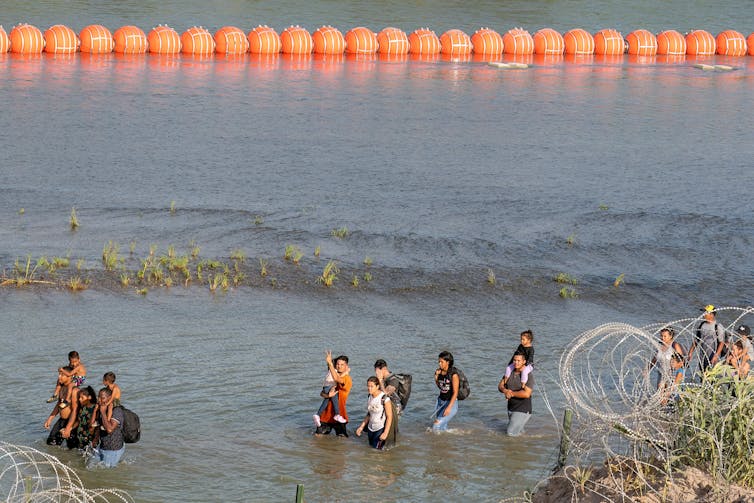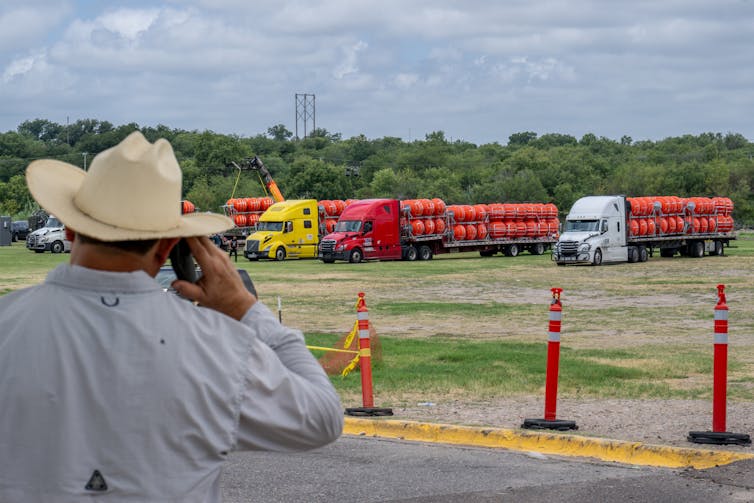Federal government is challenging Texas’s buoys in the Rio Grande – here’s why these kinds of border blockades wind up complicating immigration enforcement


The Rio Grande is only about 328 feet, or about 99 meters, wide. But the waterway dividing Texas from northern Mexico is deceptively dangerous and routinely claims the lives of migrants who try to cross it, but get caught in undetected rip currents or otherwise drown.
Now, it’s the site of a legal battle between the U.S. federal government and the state of Texas regarding the right to enact blockades in the river.
The U.S. Justice Department announced on July 24, 2023, that it filed a civil lawsuit against Texas for illegally placing a floating buoy barrier in a section of the Rio Grande that runs about 1,000 feet, or 304 meters, long.
Texas Gov. Greg Abbott rejected the Justice Department’s appeal in mid-July to remove the buoys, saying that they were necessary to keep migrants out of Texas.
The case raises questions about federal versus state control over the border – as well as whether tactics like buoys are actually effective at deterring migrants. In some cases, they frustrate immigration enforcement efforts in other ways, according to immigration legal scholar Jean Lantz Reisz.
The Conversation’s politics and society editor Amy Lieberman spoke with Reisz to better understand the significance of this conflict.
 Migrants walk between a wire fence and a string of buoys in the Rio Grande on July 16, 2023. Suzanne Cordeiro/AFP via Getty Images
Migrants walk between a wire fence and a string of buoys in the Rio Grande on July 16, 2023. Suzanne Cordeiro/AFP via Getty Images
Who controls this section of the Rio Grande?
I believe a patchwork of private owners and entities own the section of the Rio Grande where the buoys are located. And on the Mexico side it is the Mexican government – the border goes down the middle. The International Boundary Water Commission manages the Rio Grande border and is jointly run by U.S. and Mexico.
Typically, federal authorities regulate the border territories. All ports of entry are federal, for example. And a state like Texas cannot interfere with U.S. border enforcement. Texas could not claim that it owns this land and thus can erect whatever structures they want on it. And if it impedes the objective of the federal government of securing the border, that is unlawful.
But the lawsuit’s claims are more specific than this question, right?
The lawsuit alleges that Texas is violating the Rivers and Harbors Act, which is a federal act that says if a state wants to erect any structure in navigable waters of the United States, it has to seek a permit from the U.S. Army Corps of Engineers. That has to do with the federal power over interstate and foreign commerce.
Getting a permit like this would have required an investigation of potential humanitarian and environmental consequences to the buoys. I think that, in this case, the Rio Grande is a navigable water that is on the border and the permit would have been denied.
The bigger picture is that a state is impeding the federal government’s jurisdiction.
How could the buoys complicate federal immigration enforcement?
The U.S. has a strategy in enforcing the border that involves physical border patrol enforcement, drones, heat sensors and so on. So when a state comes and physically blocks off a part of the border, that frustrates the entire strategy.
It means that certain identifiable routes where people are being apprehended are now obstructed. This creates new migration routes, so people might not cross at this particular small section of the river, but they will find another section of the river and cross there, instead.
And if the buoys create an unsafe situation that results in rescue operations of migrants, it adds to the cost – not on enforcing the border, but on rescuing people.
In addition, Mexico’s cooperation is part of U.S. border enforcement strategy, and the buoys affect agreements between U.S. and Mexico over the use of the river.
 A person surveys buoy barriers before they are installed in the Rio Grande on July 7, 2023. Brandon Bell/Getty Images
A person surveys buoy barriers before they are installed in the Rio Grande on July 7, 2023. Brandon Bell/Getty Images
How often does this kind of conflict over immigration authority happen?
There have been previous legal challenges regarding Texas wanting to have control over border enforcement. Issues like state police arresting people who are in violation of immigration law – those kinds of laws have been passed in states like Texas and Arizona and were found to violate federal law.
This is because the federal government enforces immigration. The states cannot also enforce federal immigration law. States can arrest people suspected of breaking state laws, but not federal immigration laws.
In the 2012 case of Arizona v. the United States, for example, Arizona tried to penalize noncitizens for working without federal work authorization. The state authorized law enforcement to arrest people suspected of being in violation of immigration law. And the court found that Arizona could not do anything that is within the jurisdiction of the federal government, or obstruct the federal government’s objectives when it comes to immigration.





